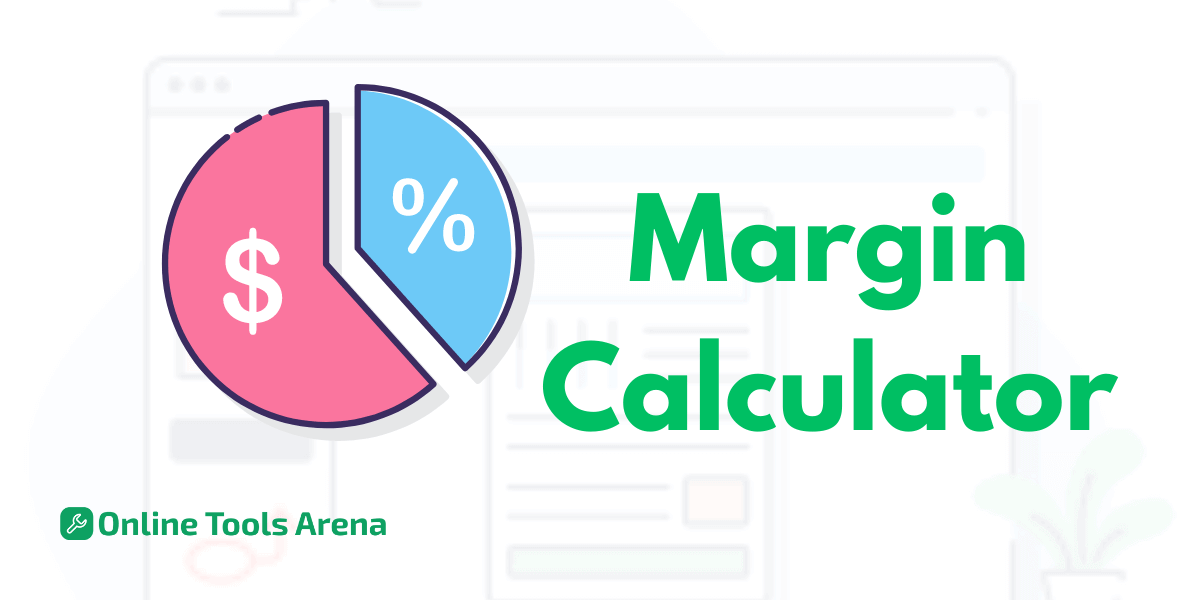
Margecalculator
Margebeheer voor financieel succes

Margin Calculator is een dynamische en effectieve oplossing voor het berekenen van de margevereisten voor een bepaalde handelspositie. Handelaren kunnen snel zien hoeveel marge er nodig is op basis van de vraagrente-invoer van belangrijke parameters zoals positiegrootte, hefboomwerking en huidige marktprijs. Deze tools stellen handelaren in staat hun risicobeheer te verbeteren, nauwkeurige beslissingen te nemen en met vertrouwen de complexiteit van margehandel te manoeuvreren. In dit artikel worden margecalculators besproken, inclusief hun relevantie voor de handel.
Table of Contents
Wat is margecalculator
De taal van margecalculators wordt gebruikt bij het verhandelen van financiële instrumenten, vooral bij het begrip margehandel. Margehandel betekent geld lenen om de omvang van de positie uit te breiden tot buiten het eigen kapitaal van de handelaar. Het wordt gebruikt op financiële markten; bijvoorbeeld aandelen, grondstoffen en buitenlandse valuta. Met de Margecalculator kunnen handelaren en beleggers de minimale marge identificeren die ze nodig hebben voor een bepaalde transactie, waarbij aspecten als de positiegrootte, de gebruikte hefboomwerking en de huidige marktomstandigheden verborgen blijven. Het houdt rekening met de waarde van de positie en berekent de marge die de makelaar in rekening brengt voor mogelijke verliezen.
De formule voor het berekenen van de marge wordt vaak uitgedrukt als:
Marge = Hefboomwerking/positieomvang × huidige marktprijs
Het is niet alleen noodzakelijk dat handelaren op verantwoorde wijze gebruik maken van marge, maar ook van cruciaal belang dat zij begrijpen dat margehandel riskant is. Hoewel dit de winsten kan vergroten, vergroot het ook de toekomstige verliezen, waardoor handelaren gedwongen worden verdere stortingen te doen zodat ze hun posities kunnen behouden als de markt tegen hen werkt. Makelaars en financiële instrumenten zullen andere regels en margevereisten hebben. Het betekent dat handelaren rekening moeten houden met deze informatie en een online margecalculator moeten gebruiken om de risico's te verminderen.
Het belang van margecalculators in de handel
Berekeningen van marges zijn van cruciaal belang bij het handelen, vooral als het om margehandel gaat. Hier zijn enkele belangrijke punten die het belang van margecalculators in de handel benadrukken:
Risicomanagement
Handelaren kunnen margecalculators gebruiken om de vereiste marge te bepalen, waardoor ze het potentiële risico en de beloning van een transactie kunnen inschatten. Hierdoor kunnen de handelaren hun blootstelling effectief afhandelen.
Dit informeert handelaren over de hoeveelheid marge die nodig is om een positie van verschillende omvang te openen, waardoor ze weloverwogen beslissingen kunnen nemen over de omvang van de positie en de hefboomwerking, waardoor ze geen hoge risico's hoeven te nemen die hen aan grote verliezen zouden kunnen blootstellen.
Positiegrootte
Margecalculatoren helpen bij het bepalen van de juiste positiegrootte voor handelaren, gegeven hun risicoprofiel en kapitaal. Door de margevereisten te bepalen, kunnen handelaren voorkomen dat ze te veel hefboomwerking gebruiken om ervoor te zorgen dat ze hun posities niet verder blootleggen dan wat beheersbaar is.
Maak gebruik van begrip
Handelaren gebruiken margecalculators om te begrijpen hoe hefboomwerking hun verhandelde posities beïnvloedt. Het begrijpen van dit feit is belangrijk bij veilig handelen, omdat hefboomwerking zowel de winsten als de verliezen kan vergroten. Met de margecalculator kunnen handelaren verschillende hefboomniveaus uitproberen en de veranderingen in de margevereisten en potentiële rendementen observeren.
Margeoproepen
Handelaren kunnen margecalculators gebruiken om te anticiperen op margestortingen en deze te vermijden. Een handelaar kan een margestorting ontvangen als een transactie hem tegenwerkt en bijna verliezen lijdt die vergelijkbaar zijn met of gelijk zijn aan de margevereiste, waardoor de handelaar wordt gedwongen extra geld aan te bieden om de positie te behouden. Handelaren kunnen daarom proactief een margecalculator gebruiken om hun margeniveaus in de gaten te houden en ze waarschuwen vooraf voor dreigende calls als er extra geld nodig is.
Naleving van de regelgeving
Makelaars op de gereglementeerde markten zijn doorgaans voorzien van bijzondere margevereisten die door toezichthouders worden opgelegd. Margecalculatoren helpen de handelaren om zich aan dergelijke voorschriften te houden en ervoor te zorgen dat ze binnen de financiële grenzen van de regelgeving handelen.
Educatief hulpmiddel
Margecalculators zijn educatieve hulpmiddelen die handelaren helpen de verwachte bedragen te berekenen, vooral degenen die nog niet eerder aan margehandel hebben gedaan. Het biedt informatie over hoe verschillende factoren, waaronder de omvang van de positie en de hefboomwerking, de benodigde marge en het daarmee gepaard gaande risico beïnvloeden.
Efficiënte besluitvorming
Margecalculators zijn belangrijke hulpmiddelen die door handelaren kunnen worden gebruikt om de financiële impact van een mogelijke aankoop duidelijk te begrijpen. Deze efficiëntie is belangrijk in tijdgevoelige markten die snelle beslissingen vereisen. Margecalculators zijn noodzakelijke hulpmiddelen voor handelaars die in deze sector verantwoordelijk willen handelen en winnende beslissingen willen nemen. Ze zijn erg belangrijk als het gaat om risicobeheer, waardebepaling en handelsdiscipline in het algemeen.
Hoe margecalculators werken
Een margecalculator houdt rekening met de belangrijkste aspecten van handel met marge om weer te geven wat de vereiste marge is met betrekking tot een open positie. De margeberekening is gebaseerd op verschillende belangrijke aspecten, waaronder de waarde van de positie, de hoeveelheid gebruikte hefboomwerking, de onmiddellijke prijs en het vooraf bepaalde dekkingspercentage van de makelaar. Hier is een overzicht van hoe margecalculators doorgaans werken:
Positiegrootte:De handelshandelaren voeren de positiegrootte in die zij zullen innemen. Het financiële instrument kan bestaan uit percelen, eenheden of contracten.
Hefboom:Om in de handel te gaan, voert de handelaar zijn geplande hefboomgebruik in de handel in. Het hefboomeffect is de verhouding tussen geld en eigen vermogen van de kredietnemer. Het vergroot zowel de winst- als de verliesmogelijkheden.
Huidige marktprijs:De handelscalculator wordt geregistreerd met de huidige prijs van een verhandeld financieel instrument. Dit is de huidige prijs voor het kopen of verkopen van het actief in de status quo.
Percentage margevereiste: Handelaren moeten een marge aanhouden die een specifiek percentage van de totale positiegrootte vertegenwoordigt, vastgesteld door makelaars. Dit was het vooraf bepaalde aantal dat de makelaar gewoonlijk voorschrijft en wordt vaak beïnvloed door wettelijke normen.
Rekenformule: De methodologie achter de margecalculator is om deze te bepalen via een formule. De basisformule wordt vaak uitgedrukt als:
Marge= Positiegrootte × Huidige markt / PriceLeverage
Weergave van resultaten: De rekenmachine toont de margevereiste, die de hoeveelheid geld vertegenwoordigt die een handelaar geacht wordt toe te wijzen en op zijn handelsrekening te behouden om de positie veilig te stellen.
Voordelen van online margecalculators
Er zijn verschillende voordelen te behalen uit deze online margecalculators, die handel met een marge mogelijk maken. Hier zijn enkele belangrijke voordelen:
Realtime berekeningen: Real-time berekeningen worden gemaakt door het gebruik van online margecalculators die naar de huidige marktsituatie kijken. Hier hebben de handelaren eenvoudig en zonder vertraging toegang tot de margevereisten van hun posities.
Gebruiksvriendelijke interface: Een intuïtieve en gebruiksvriendelijke gebruikersinterface is gebruikelijk in veel online margecalculators. Hierdoor kunnen handelaren snel toepasselijke gegevens invoeren, zoals positiegrootte, hefboomwerking en huidige marktprijzen, voor directe margeberekeningen.
Toegankelijkheid: De online margecalculatoren zijn binnen handbereik vanaf elk punt waar mensen verbinding kunnen maken met internet. Ze kunnen gemakkelijk worden gebruikt op desktopcomputers, laptops, tablets of zelfs smartphones door handelaren die op hun gemak margeberekeningen kunnen uitvoeren.
Ondersteuning voor meerdere activa:Online margecalculatoren zijn meestal multifunctioneel en werken voor financiële instrumenten zoals aandelen, forex, grondstoffen of cryptocurrencies. Het is deze flexibiliteit die het voor handelaren mogelijk maakt om marges voor verschillende activaklassen te berekenen met behulp van hetzelfde instrument.
Hulpmiddelen voor risicobeheer: Online margecalculatoren beschikken over een aantal mogelijkheden voor risicobeheer waarmee handelaren kunnen zien hoe de bewegingen die zij maken hun portefeuille beïnvloeden. Dit omvat zaken als stop-loss-niveaus en risico-opbrengstverhoudingen.
Scenario analyse: Online margecalculators kunnen worden gebruikt om scenarioanalyses uit te voeren. Ze kunnen de positiegrootte, hefboomwerking en marktprijzen variëren om de impact van die waarden op de margevereisten en mogelijke uitkomsten te zien.
Educatieve bronnen: Online margecalculators gaan vaak vergezeld van educatieve bronnen en uitleg over factoren die van invloed zijn op de margeberekeningen. Dit helpt handelaren, vooral beginners, om te weten hoe margehandel werkt en om betrouwbaardere beslissingen te nemen.
Integratie met handelsplatforms: Sommige online margecalculators kunnen ook in handelsplatforms worden geïntegreerd, zodat de handelaren niet hoeven te schakelen tussen verschillende tools bij het overdragen van gegevens en het uitvoeren van berekeningen.
Aanpassingsopties: Online margecalculators kunnen bijvoorbeeld worden aangepast, waardoor gebruikers de berekeningen kunnen aanpassen op basis van hun specifieke handelsstijl en de vereisten van makelaars.
Tijd efficientie: Het gebruik van online margecalculators helpt handelaren complexe berekeningen te vermijden en bespaart tijd. Dit is belangrijk in markten die worden gekenmerkt door hoge snelheden, waar beslissingen zeer snel moeten worden genomen.
Hoe u onze margecalculator gebruikt
- Selecteer het margetype waarin u wilt converteren.
- We bieden 3 soorten marge, winstmarge, aandelenhandel en valutawisselcalculator.
- Voer het kosten- en brutomargepercentage in.
- Klik op 'Berekenen’ om de berekening te starten.
De online margecalculator maakt ingewikkelde berekeningen eenvoudig, verbetert het risicobeheer en vergemakkelijkt de besluitvorming over gegevens uit de eerste hand. Gebruik online margecalculators in uw voordeel en vergroot uw handel. Dit zijn niet alleen maarhulpmiddelen. Ze kunnen u naar de triomf van de handel leiden. Als u het verstandig gebruikt, kunt u de risico's verminderen, de winst vermenigvuldigen en de reis beginnen om een meer succesvolle en zelfverzekerde handelaar te worden. Elke beslissing is echter van belang bij het handelen en de juiste tools kunnen een groot verschil maken. Kies daarom voor de Gratis Margecalculator Online en handel moedig.









